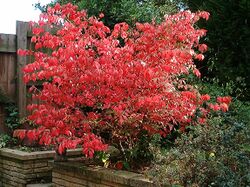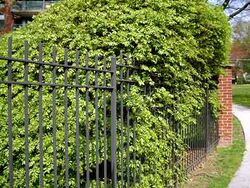Biology:Euonymus alatus
| Euonymus alatus | |
|---|---|

| |
| Scientific classification | |
| Kingdom: | Plantae |
| Clade: | Tracheophytes |
| Clade: | Angiosperms |
| Clade: | Eudicots |
| Clade: | Rosids |
| Order: | Celastrales |
| Family: | Celastraceae |
| Genus: | Euonymus |
| Species: | E. alatus
|
| Binomial name | |
| Euonymus alatus (Thunb.) Siebold
| |
Euonymus alatus, known variously as winged spindle, winged euonymus, or burning bush, is a species of flowering plant in the family Celastraceae, native to central and northern China, Japan, and Korea.
The common name "burning bush" refers to its bright red fall color.
It is a popular ornamental plant in gardens and parks due to its bright pink or orange fruit and attractive fall color. The cultivars 'Compactus'[1] and 'Fire Ball'[2] have gained the Royal Horticultural Society's Award of Garden Merit.[3]
Description
This deciduous shrub grows to 6.1 m (20 ft) tall, often wider than tall. As with the related Euonymus phellomanus, the stems are notable for their four corky ridges or "wings". The word alatus (or alata, used formerly) is Latin for "winged," in reference to the winged branches. These structures develop from a cork cambium deposited in longitudinal grooves in the twigs' first year, unlike similar wings in other plants.[4] The leaves are 2–7 cm (3⁄4–2 3⁄4 in) long and 1–4 cm (1⁄2–1 1⁄2 in) broad, ovate-elliptic, with an acute apex. The flowers are greenish, borne over a long period in the spring. The fruit is a red aril enclosed by a four-lobed pink, yellow, or orange capsule
All parts of the plant are toxic by ingestion, causing severe discomfort.[5]
Taxonomy
Euonymus alatus is native to northeastern Asia and China. In the United States, it was first introduced in the 1860s.[6]
Common names: burning bush, wing burning bush, winged euonymus, and winged spindle-tree.[6]
Distribution and habitat
Its native distribution extends from northeastern Asia to central China.[7] Besides central and eastern China, Euonymus alatus also appears in Korea, Japan, and the island of Sakhalin in Russia.[8] In its native areas, it occurs in forests, woodlands, and scrublands from sea level to 8,900 ft (2,700 m) elevation.[8]
Euonymus alatus is not native to North America. In the United States, it is found in New England, as well as Illinois, extending south to northern Florida and the Gulf Coast.[9] It is currently considered an invasive species in 21 states.
Uses
Generally cultivated for its ornamental qualities, attraction to wildlife, and ability to adapt to urban and suburban environments.[6] The shrub is commonly used in foundation planting, hedges, and along highways and commercial strips.[10] Sales across the United States are in the tens of millions of dollars every year.[10]
The corky winged stems are utilized in traditional Chinese and Korean medicine. It is used to treat conditions such as cancer, hyperglycemia, and diabetic complications.[11] Chemicals that have been isolated from this plant include flavonoids, terpenoids, steroids, lignans, cardenolides, phenolic acids, and alkaloids.[11]
Invasive species
This plant is regarded as an invasive species of woodlands in eastern North America,[12] and its importation and sale is prohibited in the states of Massachusetts,[13] New Hampshire,[14] Maine,[15] Pennsylvania, and Vermont.[16]
A new seedless cultivar, named FIRE BALL SEEDLESS (Euonymus alatus 'NCEA1') has been developed by Dr. Thomas Ranney of North Carolina State University at the Mountain Horticultural Crops Research Station in Mills River, North Carolina.[17][18]
References
- ↑ "Euonymus alatus 'Compactus' AGM". RHS Gardening. Royal Horticultural Society. https://www.rhs.org.uk/Plants/89363/Euonymus-alatus-Compactus/Details. Retrieved 23 June 2020.
- ↑ "Euonymus elatus 'Fire Ball'". RHS. https://www.rhs.org.uk/plants/171496/euonymus-alatus-fire-ball/details.
- ↑ "AGM Plants - Ornamental". Royal Horticultural Society. July 2017. p. 37. https://www.rhs.org.uk/plants/pdfs/agm-lists/agm-ornamentals.pdf. Retrieved 20 February 2018.
- ↑ Bowen, R. A. (1963). "Botanical Gazette". 124. pp. 256–261.
- ↑ "Euonymus alatus". RHS. https://www.rhs.org.uk/plants/6969/euonymus-alatus/details.
- ↑ 6.0 6.1 6.2 Wenning, Bruce (13 April 2012). "Winged Euonymus: An Exotic Invasive Plant Fact Sheet". Ecological Landscape Alliance. https://www.ecolandscaping.org/04/landscape-challenges/invasive-plants/winged-euonymus-an-exotic-invasive-plant-fact-sheet/. Retrieved 15 May 2020.
- ↑ Fryer, Janet L. "Euonymus alatus. In: Fire Effects Information System". Fire Sciences Laboratory. https://www.fs.fed.us/database/feis/plants/shrub/euoala/all.html. Retrieved 12 May 2020.
- ↑ 8.0 8.1 "Flora of China Project". eFloras.org/ Beijing: Science Press; St. Louis, MO: Missouri Botanical Garden Press. http://www.efloras.org/flora_page.aspx?flora_id=2.
- ↑ Kartesz, John T (1999). "A synonymized checklist and atlas with biological attributes for the vascular flora of the United States, Canada, and Greenland". Kartesz, John T.; Meacham, Christopher A. Synthesis of the North American Flora. North Carolina Botanical Garden. In Cooperation with: The Nature Conservancy; U.S. Department of Agriculture, Natural Resources Conservation Service; U.S. Department of the Interior, Fish and Wildlife Service 1st.
- ↑ 10.0 10.1 "Sterile Variety of Invasive 'Burning Bush' Developed". University of Connecticut.. 26 August 2011. https://www.farmprogress.com/management/sterile-variety-invasive-burning-bush-developed. Retrieved 21 May 2020.
- ↑ 11.0 11.1 Zhai, Xifeng (2016). "Euonymus alatus: A Review on Its Phytochemistry and Antidiabetic Activity". Evidence-Based Complementary and Alternative Medicine 2016: 9425714: 1–12. doi:10.1155/2016/9425714. PMID 27642361.
- ↑ Swearingen, J.; Slattery, B.; Reshetiloff, K. (2002). "Winged Burning Bush (Euonymus alatus)". Plant Invaders of Mid-Atlantic Natural Areas. National Park Service and United States Fish and Wildlife Service. https://www.invasive.org/eastern/midatlantic/eual.html.
- ↑ "Massachusetts Prohibited Plant List". Massachusetts Department of Agricultural Resources. http://www.mass.gov/eea/agencies/agr/farm-products/plants/massachusetts-prohibited-plant-list.html.
- ↑ "Fact Sheet: Prohibited Invasive Plant Species Rules, Agr 3800". New Hampshire Department of Agriculture, Markets and Food. 2017-01-31. https://www.agriculture.nh.gov/publications-forms/documents/prohibited-invasive-species.pdf.
- ↑ "Burning Bush" (in en). Maine Natural Areas Program. http://www.maine.gov/dacf/mnap/features/invasive_plants/euonymus.htm.
- ↑ "Noxious Weeds" (in en). Vermont Agency of Agriculture. https://agriculture.vermont.gov/sites/agriculture/files/documents/PHARM/Plant_Pest/NoxiousWeedsQuarantine1.pdf.
- ↑ "Spring Meadow Nursery unveils first seedless burning bush". Greenhouse Product News Oct. 13, 2023. https://gpnmag.com/news/spring-meadow-nursery-unveils-first-seedless-burning-bush/.
- ↑ "Breeding Non-Invasive Nursery Crops". https://ena.ipps.org/uploads/docs/57_139.pdf. International Plant Propagator's Society Combined Proceedings Volume 57
Further reading
- Rhoads, A. F.; Block, T. A. (2000). The Plants of Pennsylvania. University of Pennsylvania Press. ISBN 0-8122-3535-5.
Wikidata ☰ Q160578 entry
 |




